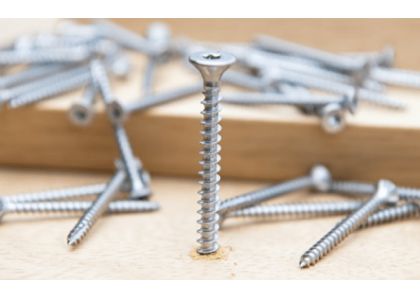
Screws, as a commonly used fastener, are widely used in various industries. Their performance and application scope are not only determined by specifications, materials, etc., but also closely related to the tooth type and head type.
Basic Specifications and Materials
The specifications of screws usually include factors such as slot type, head type, tooth type, shank diameter, pitch, and shank length. These factors together constitute the basic characteristics and performance of the screws. When describing screws, not only these specifications but also other details such as material, hardness, surface treatment, and corrosion resistance should be covered. These are all important factors that ensure the performance of screws in specific applications.
Head Type Classification and Usage
There are various types of screw heads, including expansion bolts, blind machine screws, threaded machine screws, and self-tapping screws. Each type of head has its unique design and application, suitable for different application scenarios. By understanding the characteristics of various screw heads, we can better choose and use the appropriate screws.
Application of Counterbore Screws
Counterbore screws, also known as flat machine screws or flat head screws, have a head designed as a 90-degree cone. When installing, special attention should be paid to the angle and the tightness of the fit. In some cases, due to the thickness difference of the parts being fastened, the installation method and adjustment method also vary to ensure that the screws can be correctly and tightly tightened.
Characteristics of Half-round Head Screws
Half-round head screws, due to their insulating and corrosion-resistant properties, have been widely used in multiple industries. For example, these screws perform well in medical devices, wind power and electricity, aerospace, office equipment, petrochemicals, and electronics. Their insulating, non-magnetic, and corrosion-resistant properties provide great convenience and safety in the installation of equipment in these industries.
Application of Hexagonal Screws
Hexagonal screws are suitable for applications with low precision requirements.
Different Types of Bolts
Expansion bolts, pull-through bolts, and chemical bolts are several common types of bolts. Expansion bolts use the principle of expansion force to provide tightening force through expansion, while pull-through bolts achieve fixation through tension riveting. Chemical bolts rely on chemical bonding, and due to their excellent anchoring force, they are often used in construction projects. Design and Characteristics of Threads
Thread Cross-sectional Shape
The cross-sectional shape of the thread, that is, the tooth type, determines its application and type. Common thread shapes include triangular, rectangular, trapezoidal, and serrated. Triangular threads are often used for connection, while rectangular and trapezoidal threads are widely used due to their transmission characteristics in power transmission.
Thread Type and Distribution
Threads are divided into internal and external threads, and their application on cylindrical and conical bases determines their types. External threads are commonly found on the surface of bolts, while internal threads are used on nuts to provide a fit for external threads.
Thread Rotation Direction Determination
By observing the helical line direction of the thread, it can be determined whether it is left-handed or right-handed. For example, when the thread rotates counterclockwise once, if the helical line shows a downward trend, it may be left-handed.
Single Thread and Multi-Threaded Threads
Single-threaded threads have good self-locking performance and are suitable for situations requiring thread locking, while multi-threaded threads have high transmission efficiency and are suitable for power transmission, such as in tools like vise-grips.
Naming and Parameters
The naming of threads is usually based on the nominal diameter. The main parameters include outer diameter, inner diameter, middle diameter, pitch, and thread count.